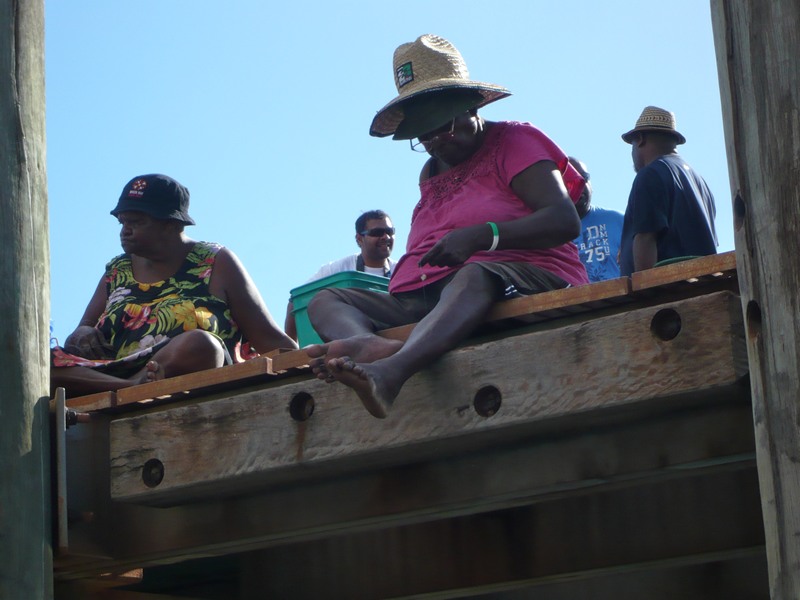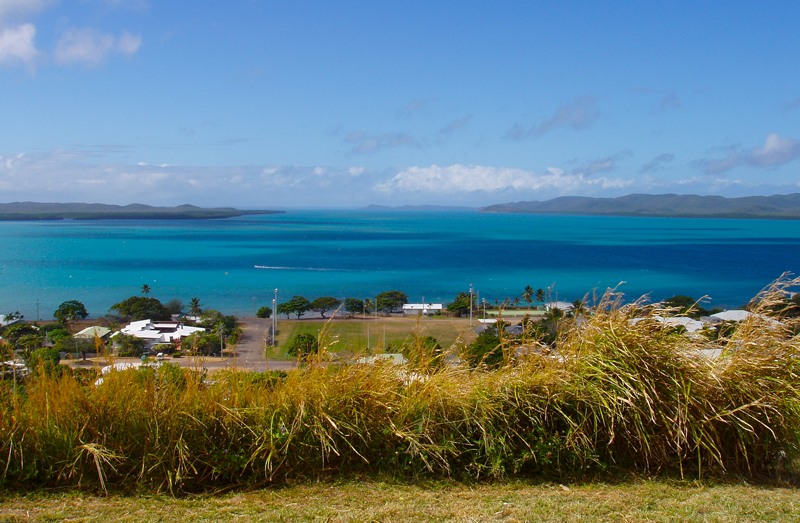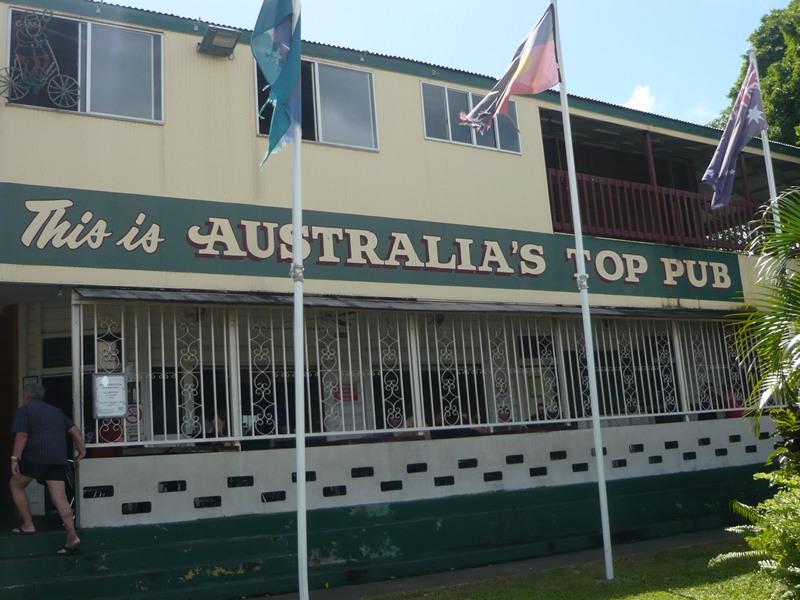Over the Top - Seisia, Queensland, Australia

Harmonie
Don and Anne Myers
Thu 22 Jul 2010 02:22
|
10:50.927S 142:21.754E
June 18th. Sailing frenzy day 6. 7
hours, 45 miles. Perfect wind. Flat water. And....we
finally made it over the top of Australia - a fairly momentous
occasion.
The trick to this short passage was leaving Escape
River as the tide was going out, but arriving at the entrance to the Albany
Passage (narrow strait between Cape York on the mainland and Albany Island) in
time for the flood tide so we could ride it through the passage and down the
other side of Cape York. Done. Just like that. We left Escape
River with the outgoing tide and just as we crossed into the Albany Passage, the
tide turned in our favor. Life was good. We had a serene sail
through the passage with the wind directly behind us and sandy beaches on either
side as we slid quietly by. Shortly thereafter we rounded Cape York with a
big sigh of relief. Finally! - that particular mass of Australia was
no longer in the way of our westward progress.
We arrived at the surprisingly delightful anchorage
off the tiny town of Seisia and stayed two nights - long enough to rest up
for our first overnight sail of the season across the Gulf of Carpentaria,
and long enough for me to see the sights while Don, once again, toiled in
the engine compartment. I honestly don't remember what exactly
needed to be fixed, but there was something. There is always
something.
Almost immediately after we set down the
anchor, a local sailor came by in his dinghy to have a chat. I
worried at first that he was going to whinge about our close proximity to his
boat (we anchored a bit close, but the place was a tad tight
overall). Instead, he welcomed us to the anchorage in true Aussie fashion
and invited us to the 'do' at the local boating club that evening. After
our six-day sailing frenzy, we were good and ready for a 'do'. He then
moved on to Storyteller and we could hear them asking about crocs in the
area. "Oh yeah, he said, there's a four meter beauty that likes to hang
around under the jetty." This while gesturing to the jetty that was not
more than 200 yards away from our anchored boats. Noticing that his dinghy
was a hefty 'tinny' and not the usual blow-up rubber variety, Sue asked how
blow-up dinghies fared with crocs around. "Ah well" he drawled, "crocs'll
use'm for teething rings." Hmmmm, comforting. Nonetheless, come six
o'clock, prime feeding time for crocs, all six of us piled into Storyteller's
heftier-than-Harmonie's blow-up dinghy and went to shore for the 'do'. We
didn't see any crocs while getting out of or into the dinghy, but we did
try to go about our business at a faster than usual pace. During the
time we spent at the 'do', John checked on the dinghy at least once to be sure
it hadn't turned into a very large reptile teething ring. It
hadn't.
The boating club (or was it a fishing club?)
consisted of a mean-looking turquoise-painted rectangle of a building - half
enclosed and half open-air with plastic tables and chairs set up for the
'do'. While the first band warmed up, we ordered our Aussie burgers (giant
burgers served with greens, tomato and signature beetroot, yes
a pickled beet slice, on top) and beer. Seisia is an
interesting place with an interesting mix of people - white Australians,
Aboriginals, Torres Strait Islanders - and the bands were a reflection of
this. The music, however, was a surprise. The first song? Eric
Clapton's 'Wonderful Tonight'. No matter where we go, we just can't get
away from the good 'ole classics. Later, however, we were lucky enough to
witness a guest performance by a local celebrity, Seaman Dan. Now in his
80's, Seaman Dan was once a 'pearler', a Torres Strait pearl diver in the '50's
and '60's (before the oysters were all fished out - now the pearls are cultured
and grow in oyster farms). After his pearling days, Seaman Dan turned to
music and is famous in Australia for his blues/reggae/Pacific island/folk singer
style.
Seisia was the first truly 'outback' town we'd
seen so far in our travels around Australia. The place is hot, and
dusty. Red dirt dusty. It is the dry season now, so presumably the
wet season turns the red dust town into a red mud town starting in
November. The roads are red dirt and the collection of four-wheel-drive
vehicles with spare tires and gasoline or diesel jugs strapped to roof
racks, and with air intake snorkels positioned well above hoods in the likely
event of a water crossing, was impressive. For backpackers and
hearty 4WD outback camping people, Seisia is the end of the road. Any
further north and they'd fall into the Torres Strait (body of water that
connects the Pacific Ocean on the east side of Australia with the Arafura
Sea to the west). Any further west and they'd
need a special permit to enter Aboriginal land. A short trip to
the east and they'd fall into the Pacific Ocean. So, they park
their red dust covered mega machines in Seisia and take a ferry to Thursday
Island, just like we did.
Or just like some of us did. As usual, John
and Don stayed behind to work on the boats while Sue, Helen, Ray and I
gallivanted off to Thursday Island on the ferry. Home to Seaman Dan,
Thursday Island is positioned in the Torres Strait, but not far from the
Australian mainland. It's a port of entry for Australia and is also the
administration headquarters for the Torres Strait Islands, which are part of
Australia. The Torres Strait Islanders are mostly Melanesian like Fijians
and Papua-New Guinea and Vanuatu people and their culture is significantly
different than that of the Aboriginal people of mainland Australia.
Visiting Thursday Island was a little like a step back in time for us as the
people are so much like many of the Pacific Islanders we've seen along the
way. Of course the Torres Strait Islanders don't live in traditional
thatch huts any more, but they still retain much of their native culture and
Thursday Island seems less a part of Australia and more the
administrative hub of an island nation. Not that it's a bustling
hub. The place is tiny and a bit third-world drab-looking, but
there were quite a few Australian construction workers feverishly finishing
beautification projects while we were there.
Thursday Island and its neighboring islands played
an important role in WWII fending off the Japanese. We took a short bus
tour and one of the highlights was the fort-turned-museum that was built in the
late 1800's to fend off the Russians and used through WWII.
Picture 1 - Cape York. It doesn't look all
that impressive, but passing it by was a huge relief.
Picture 2 - GPS position while rounding Cape
York. 10 degrees, 40 minutes south latitude. Won't be long now
before we cross back into the land of clockwise-twirling drains (or is it
counter-clockwise?).
Picture 3 - The Thursday Island ferry approaching
the Seisia jetty under which the 'four meter beauty' likes to hang
out.
Picture 4 - Aborigines fishing off the jetty at
high tide.
Picture 5 - Looking east at the Torres Strait from
the fort museum on Thursday Island.
Picture 6 - Australia's northern-most pub located
on Thursday Island. We didn't go in. Instead we opted for the
posh cafe adjacent to the cultural center.
Pictures 3, 4 and 6 courtesy of Helen.
Anne |





